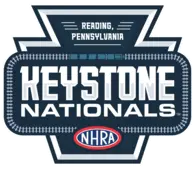

Swamp Rat Spotter's Guide, Part 1
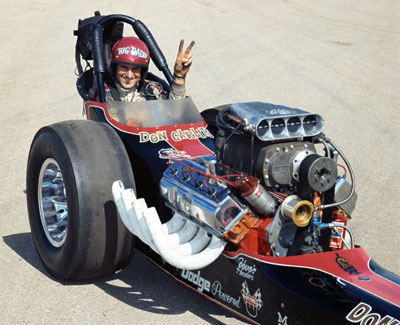 |
Ask any serious drag racing fan how many Swamp Rat entries "Big Daddy" Don Garlits had over the years, and you’re likely to be told 34, which is a pretty expected answer. After all, those fans know that "Large Father" took his last ride down the strip in Swamp Rat 34 in Indy in 2004.
Would it surprise you to know that there actually have been nearly 50 Swamp Rats? And that they weren't all fuel burners? Or that Garlits built and numbered several that he never drove? Me too!
In December, Garlits sent me a personally autographed copy of his new book, Don Garlits and His Cars, with a note asking me to "write something nice" about it, and though I thumbed through it immediately, I didn’t get a chance to give it a thorough read until this past week on my trip to and from Gainesville. I'm not going to do a book review here — I have one scheduled to run in National DRAGSTER in the near future — but I will tell you that the book tells Garlits' history in a car-by-car format that makes it an interesting forum for an autobiography that I really enjoyed.
Fancying myself quite the historian, I knew a lot of the history of many of his cars, but I'll admit that my knowledge base probably doubled after reading this book. He goes into great detail about the construction of the cars (he has a great memory for parts and people), and I found that each of the Rats has its own interesting story; most were connected in one way or another, so it sometimes got a bit confusing to follow.
The problem is that all the way through Swamp Rat 28, as many as three cars featured the same number but with a letter suffix, as with Swamp Rat III-A, Swamp Rat III-B, and Swamp Rat III-C. Garlits explains that though each was a different car, because his appearance contracts sometimes were made up to a year in advance, a promoter who paid for Swamp Rat III months earlier still wanted it, even if the car had been destroyed or replaced. Even more curious (but not explained in the book) is that the some versions of the Swamp Rat – mostly the early ones -- were designated with Roman numerals, many others in the middle with Arabic numerals, then back to Roman for XXX and Arabic for 31 through 34.
So I thought that it might be fun to try to write a Swamp Rat Spotter's Guide to give a brief description and history of each. Notice that I used the word "thought"; it turned out to be a lot more work than I expected, but I think that the results proved worth it. It’s so long that I'm going to present it in three parts in the next week. Enjoy.
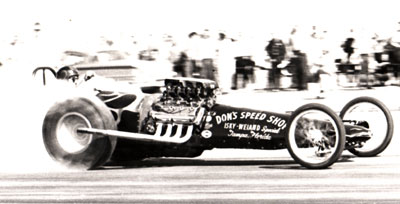
Swamp Rat I, both carbureted (above) and blown (below)
|
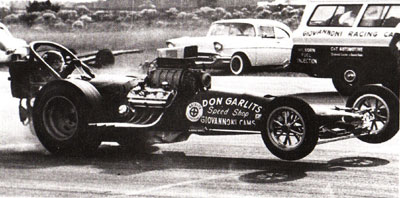 |
Swamp Rat I-A (1956-60): Although it wasn't his first dragster — he had made a crude, flathead-powered dragster from a '27-T roadster by moving the engine back and hanging a seat out over the rear end — it's the first car to wear the Swamp Rat name, though it was added much later (see Swamp Rat I-B). The car was built on the framerails of a '31 Chevy passenger car that he bought at a junkyard for $35 in 1956; Garlits removed the frame from the body in the junkyard using little more than a large axe, a cold chisel, a ball-peen hammer, and a small assortment of hand tools. He transplanted most of the parts off of the flathead dragster to this car, with the exception of the driver seat, which for SR I was an old B-17 bomber seat. Initially using Ford power, Garlits switched to Chrysler Hemi power and later to high-gear-only. The carbureted version of this car is the one that beat the nay-saying Californians in Houston but got whipped by the West Coasters in Bakersfield, but as soon as "Big" added a blower, it was all over for everyone. Unfortunately, a terrible and nearly fatal fire in Chester, S.C., on June 20, 1959, forced Garlits out of the seat.
Swamp Rat I-B (1960-61): This is actually the same car as above but modified in the cockpit area to fit the "green kid," young Art Malone, who took over the driving duties. On his first outing in the car, Malone broke Garlits’ Drag News 1320 speed record. Rival Setto Postoian took out an ad in Drag News calling Garlits a "swamp rat" for putting the young Malone in the car; Garlits thumbed his nose at Postoian by naming the car Swamp Rat, and the rest is history. Malone later quit, and Garlits drove the car until it was retired in 1961. The car went on a show-car circuit; its body was destroyed in a 1966 tornado that hit Tampa, Fla. The car sat for years until it was restored in 1979 to Swamp Rat I-A and made a nostalgic pass at more than 165 mph at the U.S. Nationals that year and in 1988 went 182 mph in Bristol. The car is now in the Don Garlits Museum of Drag Racing.
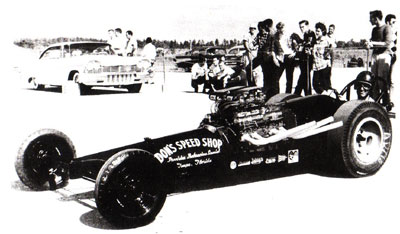
Swamp Rat Too, with the original Buick nailhead engine
|
Swamp Rat Too-A, -B, and -C (1957-61): The first was built in 1958 for Garlits' brother, Ed, who wanted to race like his two-year-older brother, and it seems from the Too designation rather than II that Garlits may not have envisioned that he would have so many cars or that the numbering scheme would define them. From 1957 through1960, this gas-powered dragster ran a Buick nailhead engine, an unblown Chrysler, an unblown small-block Chevy, and finally a supercharged Chrysler. The second car, B, was built in 1960 using rectangular tubing instead of chrome moly and proved too heavy. The super-lightweight C was the best of the bunch and won Ed the AHRA National Gas championship in 1961. Ed's wife gave him a me-or-racing ultimatum, so he sold the car, which was later destroyed in a crash. All three versions were re-created and are in the museum.
Swamp Rat III-A (1960): Built in 1960, this is the first of many, many cars on which longtime Garlits sidekick Connie Swingle laid his hands. It was Garlits' first tube-frame fueler, and he planned for Swingle to occasionally drive it while he was still wheeling SR I, but "Big" had another nasty fire in SR I, so Swingle took over Garlits' match race dates with SR III. This car went off the end of the track in Emporia, Va., after a 195-mph pass and was destroyed; Swingle suffered three broken ribs. This car was later repaired and is on display in the museum.
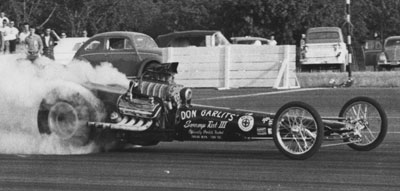
Swamp Rat III-B ran a blistering 198.66 with Connie Swingle at the wheel
|
Swamp Rat III-B (1961): This car was built in less than a week to make an upcoming match, and Garlits and Swingle didn’t have enough 4130 on hand and had to build B out of 1020 mild-steel seamless tubing. The heavy 392 caused the chassis to sag, but it still ran 8.15 in its debut, a new Drag News record. They later strengthened the chassis, but the car flipped during an exhibition run at a dirt track in Reading to promote a race at Maple Grove Raceway. Swingle went 110 down the clay front straightaway, but the car high-sided when he went left in Turn 1 and flipped over the wall, bending the chassis. The car was repaired but later destroyed in a towing accident in late 1961 in which Garlits and Swingle nearly drowned in a muddy ditch. The car was re-created in 2004, made its re-debut at the 2005 California Hot Rod Reunion, and is now in the Garlits museum.
Swamp Rat III-C (1961-62): Another Swingle rush job, but this one made from 4130, and Swingle again did the driving as Garlits had a lot going on in his burgeoning Garlits Automotive business, including the arrival of a new Max wedge Super Stock Dodge that Garlits would drive. Garlits sold III-C to Paul Vanderly, which incensed Swingle, who quit to work for Vanderly, who crashed the car on his third pass. Swingle took over as driver, but Vanderly couldn’t make money with the car and sold it to Jimmy Duet. The car disappeared after that but was re-created in 1986 for the museum.
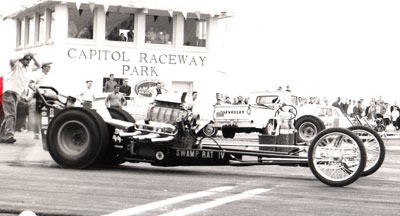
Swamp Rat IV-A, the original
|
Swamp Rat IV-A (1962): After Garlits drove the Super Stocker for a while, Dodge wanted him to put one of the new 413-cid Max wedge engines in a gas dragster to run in Indy in 1962. He hired Archie Liederbrand to help him build a new 120-inch lightweight car out of inch-and-a-half .035-wall tubing. After Garlits was runner-up in the Indy Top Eliminator final to Jack Chrisman, Swingle returned to the camp and won a big event in Kansas, then Garlits sold the car. As with III-C, the new owner quickly crashed it, and the car was destroyed.
Swamp Rat IV-B (1998): In 1998, when Garlits re-created IV-A, he replaced the Max wedge engine with a modern-day aluminum wedge and christened it IV-B. It's not clear why it wasn't just called IV-A like the other re-creations — maybe because of the different engine configuration? Garlits has since driven this car as fast as 204 mph on exhibition passes.
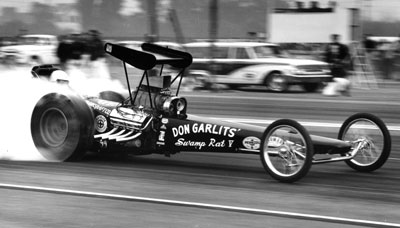
(Above) The Winternationals-winning Swamp Rat V-A. (Below) The longer SR V-B
|
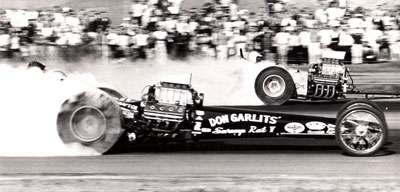 |
Swamp Rat V-A (1962-63): The famed winged car that won Top Fuel at the 1963 Winternationals — Garlits' first NHRA national event win — was built in the summer of 1962 but originally was going to be another gas dragster, with Liederbrand scheduled to drive. Garlits got a challenge from Vance Hunt to his No. 1 spot on the Drag News 1320 list and took this car to Texas to race instead. It was light and again featured a 120-inch wheelbase, and Garlits liked how it ran on fuel, but he found that at many strips, it overpowered the track. At the suggestion of Bruce Crower of Crower Cams fame, they added a fiberglass wing over the engine — modeled after an upside-down small-aircraft wing — when Garlits came to California. Frank Wylie from Dodge wanted a Garlits car for a Dodge dealers tour, and because Garlits already wanted a longer-wheelbase car, he gave them V-A. The whereabouts of this car are not known, but the car has been re-created and was most recently seen at the 50th Winternationals.
Swamp Rat V-B (1963): The newer version of Swamp Rat V was built in March 1963 and had a 140-inch wheelbase and started life with a wing. The wing struts collapsed on a run at Island Dragway, so Garlits removed it and didn’t have another winged car until he added one to Swamp Rat 14, the first rear-engine car, in 1971. Garlits drove this car extensively in 1963 and used parts of it for Swamp Rat VI-A. The car was later re-created for the museum.
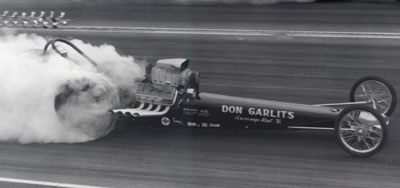 |
Swamp Rat VI-A (1964): This car is Swamp Rat V-B with a swoopy new back half, built in this fashion to save time. Because he was so enamored of its finished look with its swoopy back section, Garlits initially decided to paint this car red, but at an open event in Pomona, an opponent with a similarly red car was inadvertently given the win over Garlits, so he painted the car black. This car also was the first Wynn's Jammer entry after Garlits was paid $1,000 by the friction-proofing company to rename the car. Garlits runner-upped at the 1964 March Meet in this car and later sold it to Spencer Krumholtz, who sold it to Red Lang of Dead End Kids fame. Garlits stumbled across this car in 1997, and even though it was painted pink (!), he spied telltale body repairs that he had done 35 years earlier and bought it for $6,500 from a guy who didn’t know until much later why Garlits wanted the car so badly. The restored version is on display in the museum.
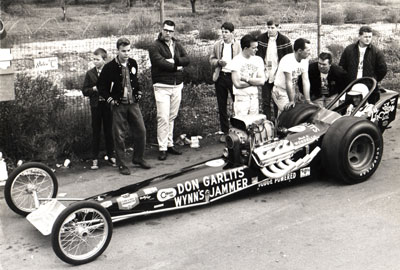 |
Swamp Rat VI-B (1964-65): Krumholtz actually had this "swoopy-tail" car on the jig at Garlits’ shop and couldn’t wait, taking VI-A instead, so this became the famous VI-B, one of Garlits' most successful entries. The car, which went to England as part of the 1964 NHRA tour and made the famous 200-mph pass at Island Dragway in August 1964, won the 1964 Nationals, set the national speed record at the 1965 Winternationals, and gave Garlits what he called one of his greatest wins, at the1965 March Meet, when he finally conquered Bakersfield. At that race, Garlits won Saturday's 64-car show, meaning that he would sit out Sunday and race the winner of Sunday's 32-car field, but Garlits instead jumped into Marvin Schwartz's Garlits-built "shop car" — the Garlits Chassis Special — for Sunday’s first round so that Schwartz could watch the car run and try to diagnose a tuning problem, but Garlits won that round and stayed in the car and beat Sunday's field, too. With no way to race two cars at the same time, Schwartz got back into his car and lost to Garlits for overall honors. Garlits had a buyer lined up for the car, but, in his last scheduled race in the car, it suffered a chute failure at Island and flipped in the shutdown area, severely damaging the car. Needless to say, the sale was off. Garlits stowed it for years behind his shop before restoring it in 1986. The car spent time in the NHRA Motorsports Museum before returning to Florida and was on display at this year's Gatornationals.
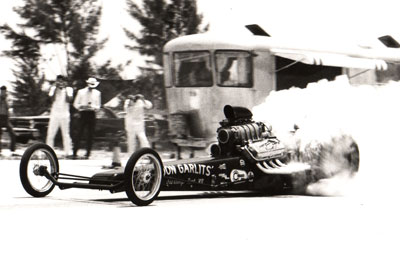 |
Swamp Rat VII-A (1963-64): Built in late 1963 and first run in early 1964 by Swingle, who took the car on tour while Garlits was driving SR VI. The car did not have the swoopy tail section of VI-A and -B because Swingle didn’t want the weight of the one-piece fiberglass tail section. The front end of the car was heavily damaged in a crash at U.S. 30, so Swingle took the engine and drivetrain and left the crumbled remains where they lay. A fan sawed off the cockpit for a groovy keepsake and years later approached Garlits and offered to give it back. In 2005, he rebuilt the car using the original cockpit.
Swamp Rat VII-B (1964): Garlits insisted that the replacement dragster have the tail section because it was very popular among those ordering chassis from Garlits — top racers such as Malone, Bobby Langley, Ron Colson, and Vance Hunt — but this car was quickly sold to Richie Bandell and Krumholtz, who also bought SR VI-A. Swingle got mad that Garlits had sold the car from underneath him (again) and quit (again). Bandell renamed SR VII-B El Kabong, and its location is unknown.
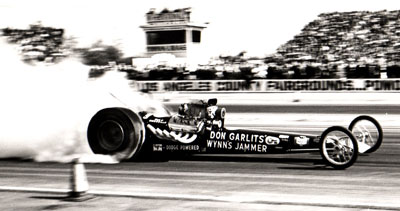 |
Swamp Rat VIII (1965): Swingle was back in the camp (again) and helped build this car and was supposed to drive it. The car was initially fitted with a torsion-bar rear suspension built by Crower. Swingle ran at the1965 March Meet, but when Chrysler told Garlits that it wanted a fuel dragster with its new 426 Hemi in it, he took off the rear suspension, relettered it as a Wynn's Jammer, and took it on a tour that was, in Garlits' words, "the worst year of my career." Garlits had moved his shop to Detroit that winter and had no place to test as he did year-round in Florida, and his performance suffered. The car performed so poorly that Garlits lengthened the chassis and rechristened it Swamp Rat X, removing Swamp Rat VIII from the face of Earth with the stroke of a paintbrush. Swamp Rat VIII has since been re-created and is often used as a cackle car.
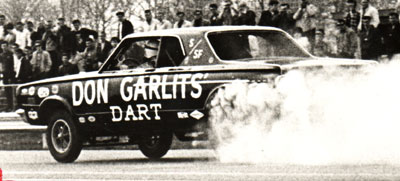
(Above) The second ill-fated rear-engine Dart. (Below) Swamp Rat IX
|
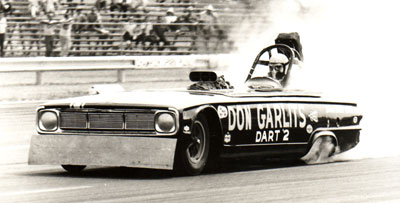 |
Swamp Rat IX (1965-66): Dubbed "the roadster Dart," it's the first non-dragster Swamp Rat but not the first Garlits Dart. The first was a rear-engine '65 piece, built in 1964 by Swingle and Garlits and fitted with the engine from SR VIII. Don Garlits' Dart, as it was called, made just one pass before the throttle hung open on Garlits at Golden Triangle Dragstrip and — in an eerie precursor to what would happen to Garlits years later at Lions — the transmission exploded, cutting the car in half. Garlits then inherited a similar car from Dick Branstner and Jay Howell and hired Emery Cook to drive it, and it, too, met a quick end, backflipping at U.S. 30. Garlits, ever eager to please Dodge, didn’t give up on the idea and, with Wylie's approval, draped a fiberglass Dart body over Schwartz's Swamp Rat VI copycat dragster chassis after shortening the wheelbase from 150 to 120 inches. They cut off the top, and Cook basically sat where the trunk was supposed to be. The car was fast and drew scorn from the other fledgling Funny Car competitors whose cars were not tube-framed; they saw it as nothing more than a cloaked dragster (which it was), so the car was forced into an altered class, where it was not competitive. The following year, NHRA allowed tube-frame Funny Car chassis. The car still ran more than 200 mph in St. Petersburg, Fla., earning the duo headlines in the drag rags. The car was retired after 1966 and sat behind Garlits' Seffner, Fla., shop for years before being restored in 1983.
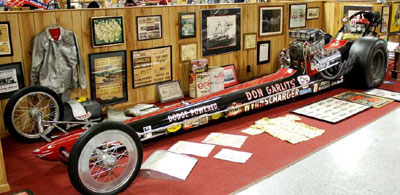 |
Swamp Rat X (1966-67): This is, as mentioned, the extended remix version of Swamp Rat VIII, and to further change the car's ill luck, Garlits had George Cerny paint it red and black while he was in California. However, 1966 still was a miserable year for him as he learned what the 426 wanted after years of running the 392 (way more timing, as it turned out). He used the same car, albeit with a different red and black paint scheme, in 1967 because he was too busy building a new house to build a new car. The car finally gave out during the 1967 Springnationals in Bristol when the frame broke and couldn't be repaired, so Garlits and team headed south to start construction on SR XI, which is where I'll pick up Tuesday. Swamp Rat X went on display in Daytona Beach, Fla., for years but now is in the museum.
OK, that's it for Part 1 of the Swamp Rat Spotter’s Guide. I'll be back with 11 through 20 on Tuesday, then will hit 21 through 34 a week from today. As always, feedback is welcomed and encouraged!

















